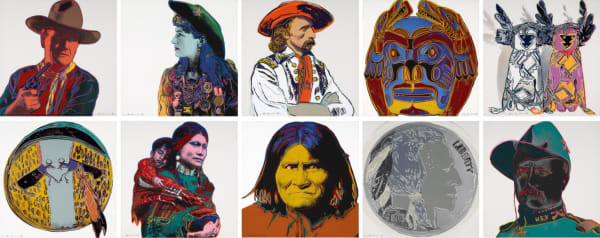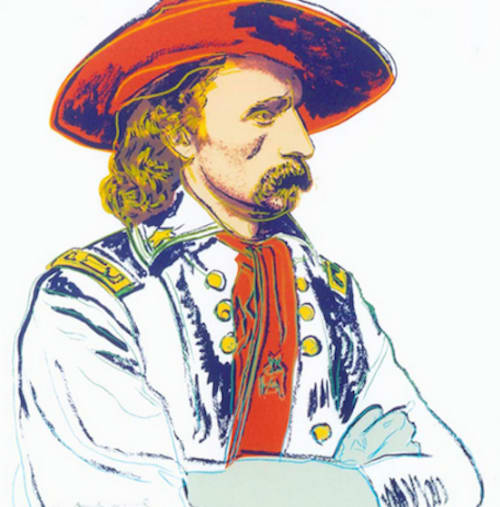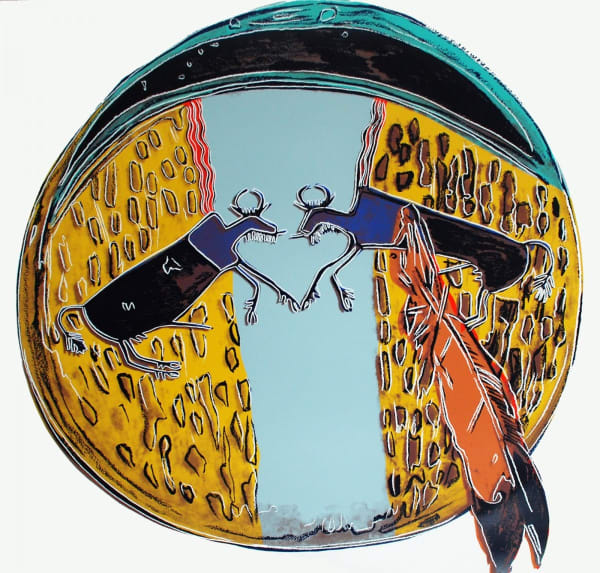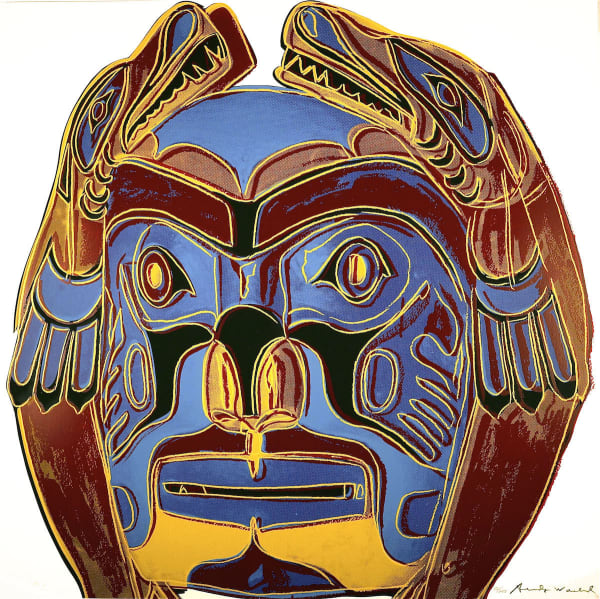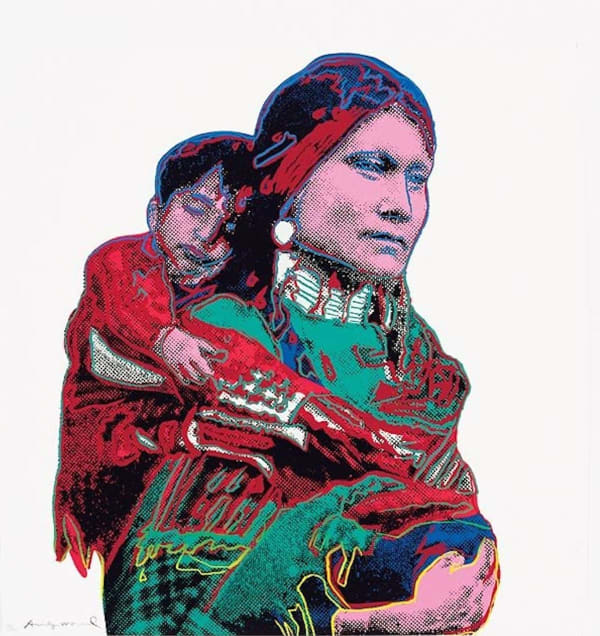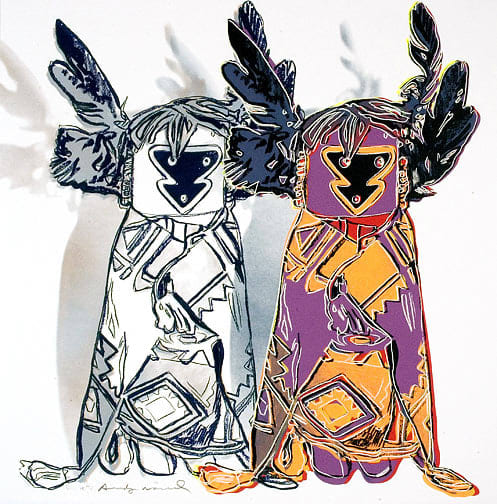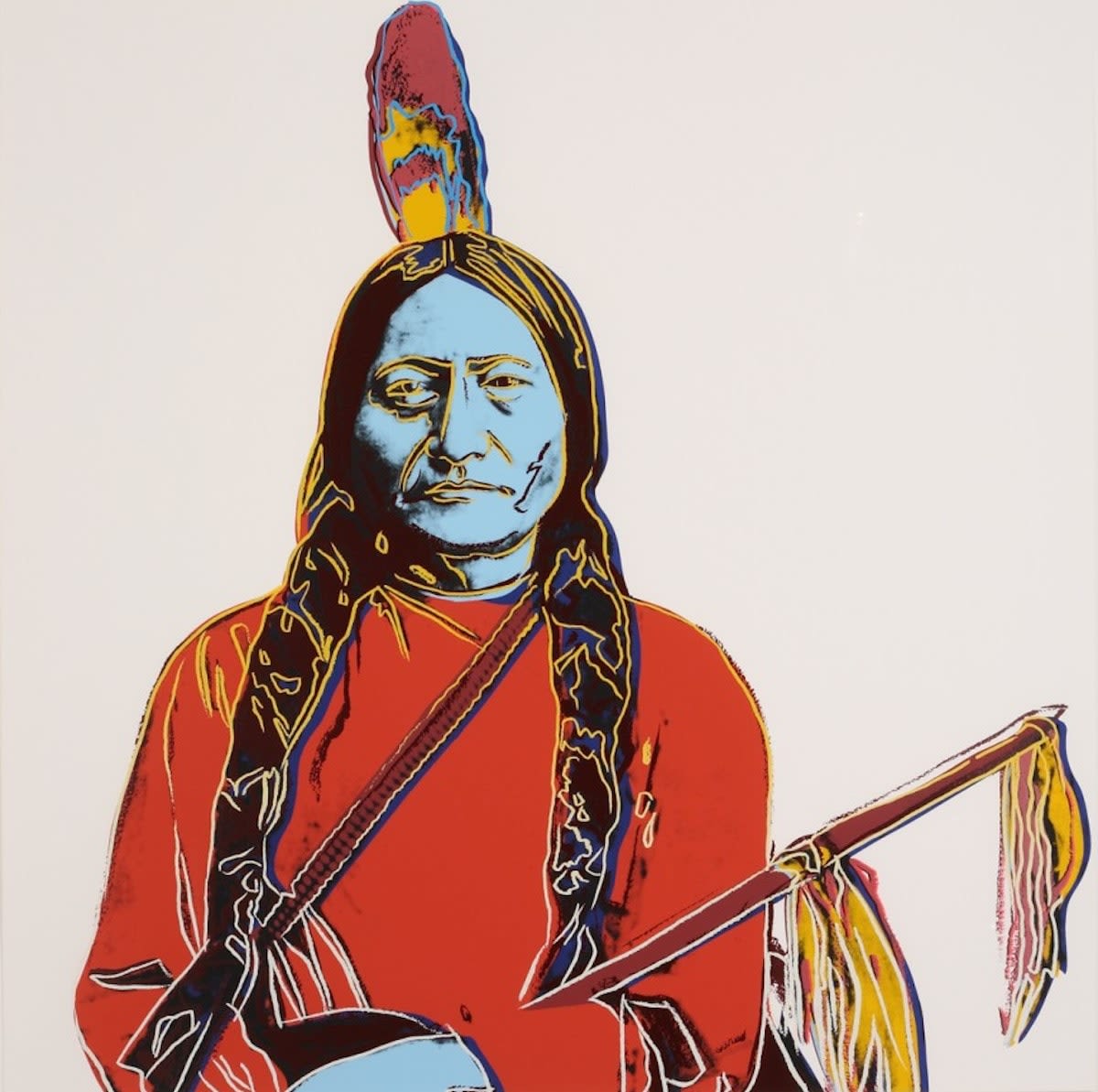
Andy Warhol
Signed and numbered
91.4 x 91.4 cm
Sitting Bull (FS.II 376) is one of four screenprints from Andy Warhol’s 1986 Cowboys and Indians portfolio, a series that examines the mythologization of the American West and its portrayal of Native American culture. Rather than presenting a historically accurate account, Warhol offers a theatrical and dramatized interpretation—one shaped by his lifelong fascination with the imagery and narratives of the Wild West. Growing up, Warhol was immersed in Hollywood Westerns, a genre that would deeply influence his visual language. Later, he even directed mock-Western films such as Horse and Lonesome Cowboys, underscoring his enduring interest in the mythology of the frontier.
In this context, Warhol’s depiction of Sitting Bull—a revered Hunkpapa Lakota Sioux leader known for resisting U.S. government policies—blends historical reverence with pop spectacle. Sitting Bull is presented not only as a figure of cultural significance but also as a contemporary icon, aligned with the larger-than-life personas that populate Warhol’s canon, including Marilyn Monroe and Chairman Mao. By doing so, Warhol invites viewers to consider how historical figures are absorbed into the machinery of popular culture and mass media.
The portrait shows Sitting Bull with a calm, resolute gaze, conveying wisdom and strength. Yet Warhol’s treatment transforms the figure through his signature use of vivid, unnatural color. The bold hues applied to Sitting Bull’s skin and clothing do not strive for realism; rather, they amplify his bravery and resistance while simultaneously placing him within the aesthetic world of Pop Art. Though the composition mimics traditional portraiture, Warhol's screenprinting technique gives it a modern, mass-reproducible quality—highlighting the tension between individuality and replication.
This tension is central to Warhol’s message. The screenprint is not only a tribute but also a critique of how Native American imagery has been commodified and distorted by mainstream culture, particularly through film and media. By reproducing Sitting Bull’s image using a process associated with mass production, Warhol mirrors how Native American figures have been repeatedly portrayed, simplified, and commercialized in Hollywood narratives.
The bold, almost confrontational colors used in the print do more than just catch the eye—they suggest how history can be rewritten, romanticized, or erased through stylization. Warhol's visual language raises important questions: What happens to cultural memory when it is filtered through popular entertainment? How do repetition and mass imagery shape our understanding of historical truth?
Through Sitting Bull (FS, II 376), Warhol blends reverence with irony. He elevates the Native American leader to the status of pop icon, yet simultaneously calls attention to how such figures are often stripped of their complexity in popular culture. The piece becomes a layered commentary—not just on the American West, but on the broader mechanisms by which media shapes identity, memory, and myth.
In placing Sitting Bull within his Cowboys and Indians series, Warhol does not merely romanticize the past; he examines how the past is continually repackaged for contemporary consumption. This screenprint is both homage and critique, a powerful visual meditation on how the American cultural imagination constructs—and consumes—its heroes.
For more information on Sitting Bull (FS, II 376) for sale or to buy Sitting Bull (FS, II 376),, contact our galleries using the form below.-
 Andy Warhol, Cowboys and Indians F.S. II 377-386 Cowboys and Indians, 1986
Andy Warhol, Cowboys and Indians F.S. II 377-386 Cowboys and Indians, 1986 -
 Andy Warhol, General Custer F.S. II 379, from Cowboys and Indians, 1986
Andy Warhol, General Custer F.S. II 379, from Cowboys and Indians, 1986 -
 Andy Warhol, Annie Oakley F.S. II 378, from Cowboys and Indians , 1986
Andy Warhol, Annie Oakley F.S. II 378, from Cowboys and Indians , 1986 -
 Andy Warhol, Plains Indian Shield F.S. II 382, from Cowboys and Indians , 1986
Andy Warhol, Plains Indian Shield F.S. II 382, from Cowboys and Indians , 1986 -
 Andy Warhol, Northwest Coast Mask F.S. II 380, from Cowboys and Indians , 1986
Andy Warhol, Northwest Coast Mask F.S. II 380, from Cowboys and Indians , 1986 -
 Andy Warhol, Teddy Roosevelt F.S. II 386, from Cowboys and Indians , 1986
Andy Warhol, Teddy Roosevelt F.S. II 386, from Cowboys and Indians , 1986 -
 Andy Warhol, Mother and Child F.S. II 383, from Cowboys and Indians , 1986
Andy Warhol, Mother and Child F.S. II 383, from Cowboys and Indians , 1986 -
 Andy Warhol, Kachina Dolls F.S. II 381, from Cowboys and Indians , 1986
Andy Warhol, Kachina Dolls F.S. II 381, from Cowboys and Indians , 1986 -
 Andy Warhol, Indian Head Nickel F.S.II 385, from Cowboys and Indians , 1986
Andy Warhol, Indian Head Nickel F.S.II 385, from Cowboys and Indians , 1986 -
 Andy Warhol, John Wayne F.S. II 377, from Cowboys and Indians, 1986
Andy Warhol, John Wayne F.S. II 377, from Cowboys and Indians, 1986 -
 Andy Warhol, Geronimo F.S. II 384, from Cowboys and Indians, 1986
Andy Warhol, Geronimo F.S. II 384, from Cowboys and Indians, 1986
Join our mailing list
* denotes required fields
We will process the personal data you have supplied in accordance with our privacy policy (available on request). You can unsubscribe or change your preferences at any time by clicking the link in our emails.
177 10th Avenue
Ground Floor
New York, NY 10011
Tuesday - Friday 10am - 5pm
Saturday 11am - 5pm
info@guyhepner.com
+1 (212) 500 8190
This website uses cookies
This site uses cookies to help make it more useful to you. Find out more about cookies.
